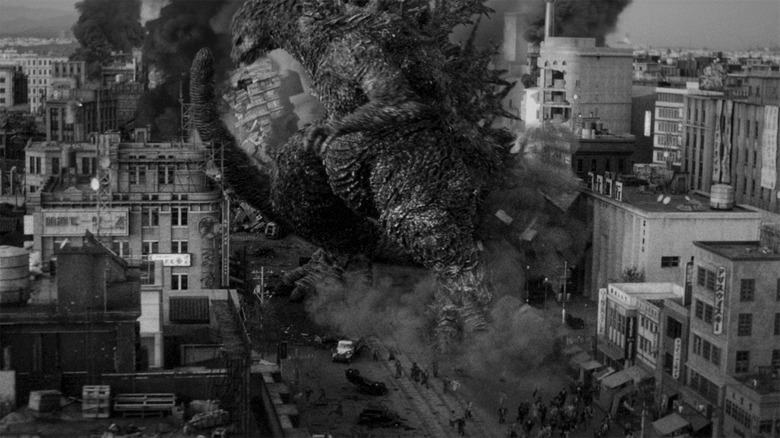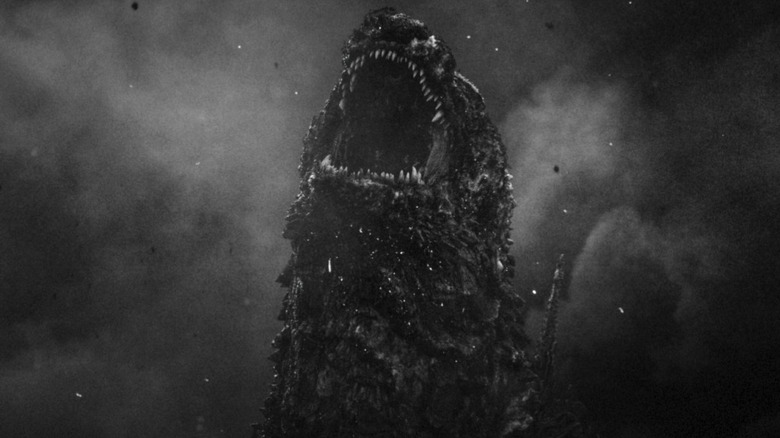Godzilla Minus One/Minus Color Is More Than Just A Black-And-White Rehash

One of the biggest cinematic surprises of the last year was, without a doubt, “Godzilla Minus One.” It may have been difficult for longtime fans to imagine an entry from this franchise hitting such a high bar nearly 70 years into its existence, but director Takashi Yamazaki’s film delivered the goods – so much so that it became the first and only “Godzilla” movie to earn an Oscar. Those who have watched it are certainly aware that “Minus One” is great, but even for those who have already seen it and are well aware of what the film has to offer, there is a strong argument to be made for watching the movie again in an entirely new way.
Amid the film’s record-breaking theatrical run, its distributor, Toho, released the “Minus Color” edition, which, as the title implies, is Yamazaki’s World War II-era take on the King of the Monsters in black-and-white. Recently, “Godzilla Minus One” finally arrived on Netflix and VOD, opening it up to an entirely new audience after not being available to watch anywhere in North America after it left theaters. The film quickly entered the top 10 on Netflix in addition to digital retailers such as Apple TV, meaning lots of people have already seen it. But the “Minus Color” edition will be available to stream on Netflix starting on August 1, 2024, and this version is also well worth your time.
There are countless movies to watch on streaming at any given moment, making it tough to justify watching the same thing more than once — particularly in the span of just a few weeks. But this is not merely the same movie with the color removed; the black-and-white version truly does allow audiences to watch a tremendous piece of cinema through an entirely new lens.
Godzilla Minus Color is more than just a black & white retread
What “Minus One” does better than any “Godzilla” movie since the original 1954 classic is put audiences in the shoes of a country recovering from the atrocities of war. It’s a very serious film, running in stark contrast to something like “Godzilla x Kong: The New Empire” or the other MonsterVerse films. Those are certainly enjoyable and have a huge audience, but this is a franchise that can shoulder more than just big kaiju beat-’em-ups. By giving the movie a very detailed black-and-white makeover, it adds to the feeling of watching something made in the 1940s, given that many films from that period were shown in that color scheme.
There’s a somewhat haunting quality to this new version, and much of that has to do with Yamazaki’s approach to recoloring the film. In an interview with The Wrap, the filmmaker explained that they did an awful lot more than just put it through a color filter:
“The original 1954 ‘Godzilla’ is, of course, in black-and-white. But that in and of itself made us interested in what a ‘Godzilla’ film would look like created with modern technology in black-and-white. But simply removing the color alone wouldn’t evoke the same type of emotion we were trying to instill in audiences, which is why we went back to the colorist and we actually mask[ed] different portions of each shot and adjust[ed] the contrast by hand, as opposed to simply hitting the ‘remove color’ button.”
The process used to create this new version made it feel “like it was composed by a professional still photographer.” The director also said that “Minus Color” is “way scarier,” noting that “even the team members working on it, we’d get goosebumps…Because, in many ways, it does feel like a different film.”
Two great Godzilla movies in one
In that same interview, Yamazaki concluded, “For us, removing the color in some way increases the reality, feeling almost like a documentary and making audiences feel that Godzilla actually exists.” For as much as it’s incredibly difficult for a movie about a giant radioactive monster to feel real in any way, this version of the film does manage to bring a grounded sense of realism to the events in a way that even outdoes the color version. That’s part of the reason picking up the “Godzilla Minus One/Minus Color” collector’s edition Blu-ray might be worth it for hardcore fans, even if it does have some drawbacks. Both versions of this film deserve a place on one’s physical media shelf.
But understandably, not everyone who enjoys a “Godzilla” movie now and again wants to spend $65 on something they might watch once or twice. Fortunately, Netflix is making it incredibly easy for anyone with a subscription to watch this totally fresh take on this acclaimed modern masterpiece. It’s not often that multiple versions of the same film make their way to a major streaming service these days, allowing people the opportunity to experience greatness in multiple ways. In the streaming era, where so much of what is put out into the world can feel disposable, this feels special.
It’s not every day that a 70-year-old franchise is subject to such brilliant reinvention. That’s worth celebrating, as is the fact that Yamazaki and Toho managed to deliver two different versions of this masterpiece that both offer something unique to the viewer. “Minus Color” is absolutely worth your time – just be sure to watch it with subtitles rather than with the terrible English dub.
“Godzilla Minus One” is streaming now on Netflix, and “Minus Color” arrives on August 1, 2024.
Source link






